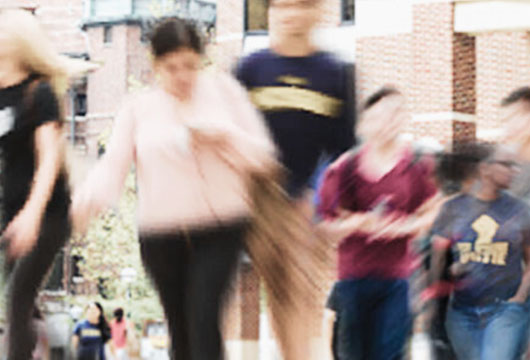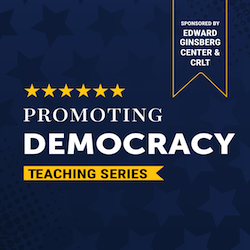
How can we promote academic success for all students who enter the University, particularly those students from disadvantaged backgrounds? How can we help students overcome their own anxiety about achievement and get past “stereotype threat?” How can we increase retention rates--both for particular majors and at U-M generally--by encouraging students’ to see their abilities as malleable, rather than fixed? In early February, U-M Department of Psychology faculty member Bill Gehring addressed these topics at an LSA faculty seminar on Diversity and Climate. His research-based strategies can provide direction for instructors in all fields to enhance diversity and academic success at U-M.
In his presentation, Professor Gehring described four evidence-based interventions that work to create “identity-safe” classrooms:
(1) Seeing Students Holistically: It is important for faculty to recognize that students’ performance in class can be affected by many factors beyond intelligence. For example, Professor Gehring’s research on students in his Psychology 111 course found that students’ motivation to do well was positively related to their performance on exams, while their anxiety about testing was negatively associated. To increase motivation, faculty can help students set goals for their learning, and to decrease anxiety, more frequent, lower-stakes assessments may help. Other “non-cognitive” factors related to performance include discipline (i.e., the ability to resist distractions and procrastination). To reduce distractors, Gehring recommends that students not bring laptops to class, as his research finds a statistically significant decrease in exam grades among students who almost always bring their laptops, compared to less frequent users.
(2) Framing Disappointment: The first undergraduate year can be a struggle, given that many students come into U-M at the top of their classes yet underperform relative to their expectations. (Incoming student survey data from the Cooperative Institutional Research Program indicate that 75% anticipate having at least a “B” average.”) Similarly, many students experience doubts about making friends and fitting in socially.
Faculty can help students frame these potential disappointments, so students do not give up but see challenging events as opportunities for growth. Gehring notes that faculty can explicitly tell students that many undergraduates have difficulties at first, yet grades typically go up after the first year and worries about social belonging also decrease. (Wilson, Damiani & Shelton, 2002, summarize several studies showing positive effects of these normalizing statements on improving students’ academic performance and retention.) Helping students keep sight of their long-term goals has also been found to be effective. In a study published in Science, researchers found that having students complete a short “values affirmation” – a brief writing exercise at the beginning of the term about why values such as family or career achievements are important to them – reduced disparities in exam performance (Miyake et al., 2010).
(3) Helping Students to Manage Stereotype Threat: “Stereotype threat” can harm academic performance of students for whom there is a socially-held negative expectation about poor performance – such as women in science -- and it can have a significant impact on students’ test-taking activity (Steele & Aronson, 1995). Prof. Gehring notes that U-M has “perfect storm” of factors that exacerbate stereotype threat, e.g., its large classes and student demographics. Faculty can help by using student-centered teaching methods and by providing positive and diverse examples of researchers in the field. Studies also have indicated that if faculty explicitly note that their tests do not show bias, stereotype threat can be negated (Good, Aronson, & Harder, 2008; Spencer, Steele, & Quinn, 1999).
(4) Encouraging a Growth Mindset: Researchers such as Carol Dweck (2007) note that students who have a “fixed” view of intelligence tend to give up when facing challenges. In contrast, those with a “growth mindset”—who see intelligence as malleable—see challenges as opportunities to improve and seek out new ways to learn even if they are risky. Faculty can help encourage adaptive responses by praising students’ effort, rather than only their achievements, and verbally reinforcing the benefits of a growth mindset.
Other CRLT resources on inclusive teaching, based on the science of learning, can be found on our Teaching for Equity and Inclusion pages.
Sources Cited:
Good, C., Aronson, J., & Harder, J.A., (2008). Problems in the pipeline: Stereotype threat and women’s achievement in high-level math courses. Journal of Applied Developmental Psychology, 29(1), 17-28.
Miyake, A., Kost-Smith, L.E., Finkelstein, N.D., Pollock, S.J., Cohen, G.L., & Ito, T.A. (2010). Reducing the Gender Achievement Gap in College Science: A Classroom Study of Values Affirmation. Science, 330(6008), 1234-1237.
Spencer, S.J., Steele, C.M., & Quinn, D.M., (1999). Stereotype Threat and Women’s Math Performance. Journal of Experimental Social Psychology, 35(1), 4-28.
Steele, C.M., & Aronson, J. (1995). Stereotype threat and the intellectual test performance of African Americans. Journal of Personality and Social Psychology, 69(5), 797-811.
Wilson, T.D., Damiani, M., & Shelton, J.N. (2002). Improving the academic performance of college students with brief attributional interventions. In J. Aronson (Ed.), Improving academic achievement: Contributions of social psychology (pp. 89-108). San Diego: Academic Press.
Image credit: Jean-Rémy Duboc on Flicker (CC BY-SA 2.0)
- Log in to post comments
- 789 views






